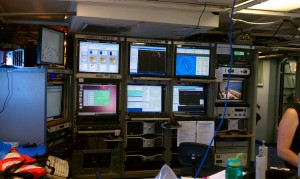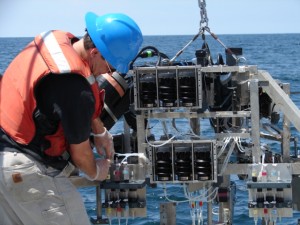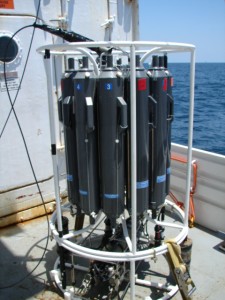And the Lander Returns…
 This morning all were ready for the first water sample collection that would be taken and kept from the CTD. At promptly 8:30 am the CTD was launched into the water with all of its bottles open and ready to be closed with sample water. The CTD was deployed to 27 meters (30 meters being the bottom here). We left 3 meters between the bottom and the CTD to ensure that it wouldn’t hit the ground. At 27 meters we recorded the temperature, salinity, and oxygen levels of the surrounding water and fired off for one bottle to be closed. I asked the “doghouse” (the crane-operator) to bring up the CTD 2 meters from its initial position- to a depth of 25 meters. We repeated the same measurements and closed yet another bottle. We continued this procedure for 10 more bottles until we reached 1 meter below the surface. This allowed us to collect a sample of water every 2 meters from just above the bottom of the sea to just below the surface.
This morning all were ready for the first water sample collection that would be taken and kept from the CTD. At promptly 8:30 am the CTD was launched into the water with all of its bottles open and ready to be closed with sample water. The CTD was deployed to 27 meters (30 meters being the bottom here). We left 3 meters between the bottom and the CTD to ensure that it wouldn’t hit the ground. At 27 meters we recorded the temperature, salinity, and oxygen levels of the surrounding water and fired off for one bottle to be closed. I asked the “doghouse” (the crane-operator) to bring up the CTD 2 meters from its initial position- to a depth of 25 meters. We repeated the same measurements and closed yet another bottle. We continued this procedure for 10 more bottles until we reached 1 meter below the surface. This allowed us to collect a sample of water every 2 meters from just above the bottom of the sea to just below the surface.
After recording temperature, salinity, oxygen, and depth and closing the bottles and bringing them up to the surface the scientists, Will, Jim, and Kanchian initially, started their water collection (with the help of their assistants Meghan and April). Each scientist is interested in various chemicals that the water holds. Some of these interests overlap and some do not, r equiring that each scientist collect his/her own sample for testing.
equiring that each scientist collect his/her own sample for testing.
After water sample collection from the CTD’s there was some time for scientists and assistants to take a little break; the next activity was to retrieve the Lander that Will Berelson and his team deployed yesterday. Pat, Jim, Will, Nick, Meghan, April, Chris, and Kevin worked hard to bring the Lander up from the depths and deposit it safely onto the Endeavors deck. It wasn’t that easy however, getting the Lander up proved to be quite a challenge, even for this experienced lot. After nearly an hour the Lander finally made it on board and the crew disassembled for one last time before Silke would deploy her “GO-Flo’s.”
The use of “GO-Flo’s” for Silke serves a primary purpose. The GO-Flo works much the same way that the CTD works, with a couple of primary differences. The CTD has 12 bottles attached to a single “rosette,” or metal stand. As the rosette is lowered to different depths the bottles are closed one by one via a remote controlled sensor on the ship. The CTD also has gages that record and transmit data regarding conductivity (which gives salinity), temperature, and depth back to computers on board the Endeavor. The GO-Flo doesn’t have any of these sensors. It’s basically a long piece of rope that has the bottles used to collect the samples attached at the different depths along the rope, along with a giant weight on the bottom to pull it down smoothly. The entire rope is dropped into the depths with the bottles attached. After all of the rope and bottles are deployed a “messenger” (signal) will run down the length of the rope and tell the bottles to close, trapping the water at that particular depth inside the bottles. The bottles will be retrieved and sampled by the scientist, in this case Silke Severmann.
 So both devices perform the same job in different ways. Bu
So both devices perform the same job in different ways. Bu t why use the GO-Flo you ask? Especially since the CTD is easier, newer, and more efficient/accurate to use? Don’t forget that Silke is studying iron. A trace metal in these waters. That means that there is very little of it at all. She’s concerned that using the metal rosette might contaminate her water samples. By using the GO-Flo Silke is avoiding the possibility that her samples could be contaminated from those sources since the GO-Flo is made up entirely of non-metal parts. Silke deployed the GO-Flo and retrieved all 5 bottles just in time for dinner. After our meal we headed out for two last efforts.
t why use the GO-Flo you ask? Especially since the CTD is easier, newer, and more efficient/accurate to use? Don’t forget that Silke is studying iron. A trace metal in these waters. That means that there is very little of it at all. She’s concerned that using the metal rosette might contaminate her water samples. By using the GO-Flo Silke is avoiding the possibility that her samples could be contaminated from those sources since the GO-Flo is made up entirely of non-metal parts. Silke deployed the GO-Flo and retrieved all 5 bottles just in time for dinner. After our meal we headed out for two last efforts.
Kanchan Maiti was ready to deploy his in-situ pumps. Read more about how the in-situ pumps work under the “In-situ pump” link under the expedition technology heading. After being deployed for 2 hours the in-situ pumps were brought up to the surface and the material left behind on the filters was analyzed by Kanchian.
The last activity of the day was to perform a final CTD. For this one, Will wanted to obtain a sample of seawater from 30 m (the same depth his Lander was deployed at). We found a location where the water was deeper than 30 m and dropped the CTD to the 30 m mark, clicked a button, and a bottle closed, sealing in water from that depth. Bill and I brought the CTD home for its final retrieval of the day. I hear tomorrow is bringing lots of sample collection so I’m going to head off to bed.
Ciao for now,
Wessal


 August 1, 2011
August 1, 2011 






Recent Comments